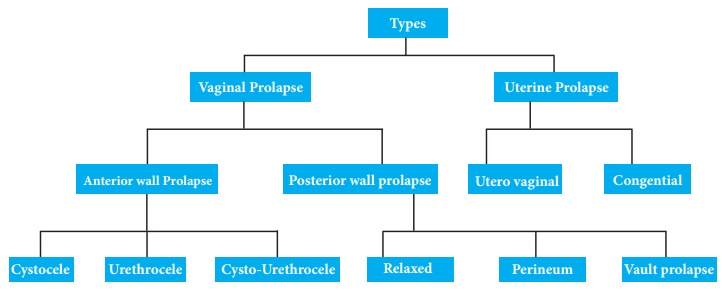Definition, Types, Causes, Signs and Symptoms, Diagnosis, management - Uterine Prolapse | 12th Nursing : Chapter 2 : Medical Surgical and Applied Nursing Management Psychology of Human Diseases
Chapter: 12th Nursing : Chapter 2 : Medical Surgical and Applied Nursing Management Psychology of Human Diseases
Uterine Prolapse
Uterine Prolapse
Uterus (or womb) is normally held in place inside pelvis with various
muscles, tissue, and ligaments. Because of pregnancy, childbirth or difficult
labor and delivery, in some women these muscles weaken. Also, as a woman ages
and with a natural loss of the hormone estrogen, the uterus can drop into the
vaginal canal, causing the condition known as a prolapsed uterus
Definition
Descend of uterus from its normal position in the pelvis further
down into the vagina.
Types
First degree: The cervix drops into the vagina.
Second degree: The cervix drops to the level just inside the opening of
the vagina.
Third degree: The cervix is outside the vagina.
Fourth degree: The entire uterus is outside the vagina. This condition
is also called procidentia. This is caused by weakness of the supporting
muscles.

Risk factors
•
Excess weight lifting
•
multiple deliveries
Causes
•
Pregnancy/childbirths with normal or complicated delivery through
the vagina
•
Advancing age with weak pelvic muscles
•
Weakening and loss of tissue tone after menopause and loss of
natural estrogen
•
increased pressure in the abdomen such as chronic cough
•
Major surgery in the pelvic area leading to loss of external
support
•
Smoking
Signs and Symptoms
•
Pelvic heaviness or pulling
•
Vaginal bleeding or an increase in vaginal discharge
•
Difficulties with sexual intercourse
•
Urinary leakage, retention or bladder infections
•
Bowel movement difficulties, such as constipation
•
Lower back pain
•
Uterine protrusion from the vaginal opening
•
Sensations of sitting on a ball or feeling of something is falling
out of the vagina
•
Weak vaginal tissue
Diagnosis
Diagnose uterine prolapse with A medical history and physical
examination of the pelvis.
•
Intra Venous Pyelogram (IVP)
•
Renal sonography.
•
X-rays.
•
Ultrasound.
•
Vaginal examination
•
Rectal examination.
Management
Prolapse up to the third degree may spontaneously resolve
Complications
•
Infertility
•
Abortion
•
Preterm labour
• Risk of operative delivery
•
Anaemia due to heavy bleeding
•
Uterine cancer
Vaginal pessary: It is a removable device placed into the
vagina.
Surgery: Hysterectomy
Nursing management
Teach and insist to practice Kegel exercise during pregnancy and
post natal period
Exercise
•
Mild uterine prolapse can be treated with Kegel exercises
•
Tighten the pelvic floor muscles, as you are attempting to stop
urinating and hold for 5 seconds
•
Take a 5-second break and repeat for three to 10 times per day.
•
Avoid more child birth.
Prevention
•
Maintain optimal weight.
•
Avoid constipation by eating a high-fiber diet.
•
Perform Kegel exercises to strengthen the pelvic muscles.
•
Avoid heavy lifting or straining. Preventing and treating
constipation
•
Avoid chronic cough
Related Topics